

Nepal earthquake's open wounds. On the streets, there are rumours.
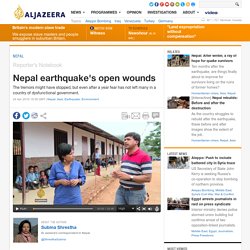
At shops, people murmur to each other that there is a plague of earthquakes going around the world. Some are convinced that the quake is coming back to Nepal. Nepal earthquake: Patience wearing thin one year on. Image copyright AP A year after the earthquake and Nepal is still a country of tarpaulins, tents and tin-roofed shacks.
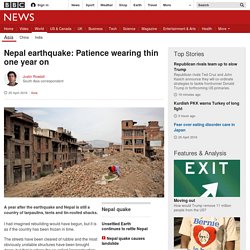
I had imagined rebuilding would have begun, but it is as if the country has been frozen in time. The streets have been cleared of rubble and the most obviously unstable structures have been brought down, but that is where the so-called "reconstruction effort" stopped. Virtually none of the 800,000 buildings it is reckoned the quake destroyed have been rebuilt. The lack of progress is most stark in the countryside. I am expecting boiling anger when I go back into one of the worst-hit provinces, Sindhupalchowk. But instead I find something much more depressing: hopeless resignation. 'No-one has helped us' Powerful Photos Show Enduring Devastation of Nepal Earthquakes. The earthquakes that killed thousands last year have left many homeless and struggling today.
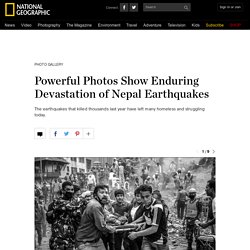
A year ago Monday, a 7.8-magnitude earthquake rattled Nepal, causing the deaths of nearly 9,000 people, injuring 22,000, and forcing more than one million to lose their homes. At least 120 aftershocks followed. Less than a month later, on May 12, a 7.3-magnitude quake hit eastern Nepal, near Everest. More than 100 people were killed and thousands were injured. The quakes damaged many of the country's historic sites, from temples to monuments.
Since then, Nepal has struggled to rebuild. Spain-based photographer Omar Havana was living in Nepal when the earthquakes struck and his images of the aftermath were published widely. Nepal earthquake: Victims still living in tents one year on as foreign tourists shun the country. Updated On the anniversary of its worst natural disaster in living memory, Nepal is still a country in crisis.
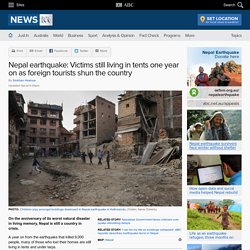
Key points: Despite $4 billion in donations, many survivors have had no government helpPoorest people sleeping under plastic sheeting or in tin sheltersCollapse of tourism industry after quake devastates economy. A year on from the earthquake, we volunteers are rebuilding Nepal. When the earthquake struck I was at home.
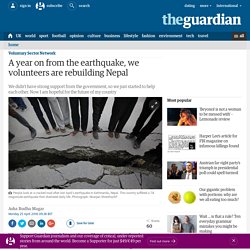
My mum was at work and my brothers and sisters were at college. I came out of my room, where I had been hiding under the bed, went into the kitchen and saw water falling down the walls, and everything was on the floor. People were crying and gathering together. I called my sister, but the phone rang once and then went off. Nepal earthquake one year on – video. Nepal earthquake: How is country faring one year on? Image copyright PA As Nepal marks the first anniversary of its devastating earthquake, the BBC Nepal's Surendra Phuyal assesses how the country has been coping.
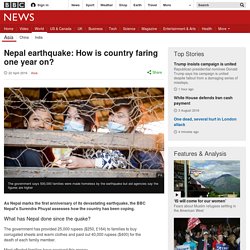
What has Nepal done since the quake? The government has provided 25,000 rupees ($250, £164) to families to buy corrugated sheets and warm clothes and paid out 40,000 rupees ($400) for the death of each family member. Most affected families have received this money. The Himalayan nation has also assessed the loss and damage caused by the quake, but has yet to officially kick start its much-delayed reconstruction mission. Image copyright AFP The National Reconstruction Authority (NRA) was only set up in December 2015. The authority is seeking 811 billion rupees ($8bn) to implement its reconstruction programme for the next five years. NRA spokesperson Ram Thapaliya told BBC Nepali that international donors are being asked to extend their commitment for reconstruction programmes. Nepal earthquake anniversary: one year on, not one home rebuilt by government.
Nepal earthquake: Patience wearing thin one year on. In pictures: Nepal aftershocks. Nepal earthquake: The pictures taken by you then and now. Image copyright Kashish Das Shrestha One year after a massive earthquake hit Kathmandu and its surrounding areas, we return to some of those we spoke to at the time.
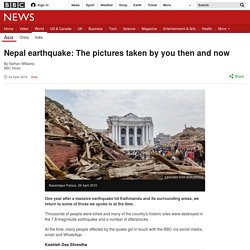
Thousands of people were killed and many of the country's historic sites were destroyed in the 7.8-magnitude earthquake and a number of aftershocks. At the time, many people affected by the quake got in touch with the BBC via social media, email and WhatsApp. Kashish Das Shrestha Kashish says his main memory of the immediate aftermath of the quake was the sense of trauma on the street.
He wanted to get the word out about what was happening and let his family and friends know he was alive, so he started tweeting. Image copyright Twitter He also took his camera with him and went to Kathmandu's old city. "I'm a fourth generation photographer - my family have always extensively documented Kathmandu. 'I don’t feel safe but life must go on': one year on from the Nepal earthquake.
Straddling the faultline between the Eurasian and Indian tectonic plates, Nepal is no stranger to earthquakes.
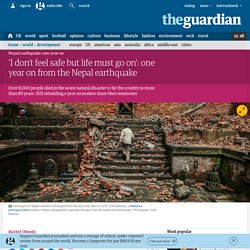
But just before noon on 25 April 2015 the country was struck by a 7.8-magnitude quake injuring more than 21,000 and leaving millions homeless. Stories of survival and hope after Nepal's earthquake – a photo essay. Patience wears thin among Nepal quake survivors as calls for help go unheeded. The villagers gather on top of a mountain in Nepal’s Sindhupalchowk district, on the sun-spotted ground in the canopy of two trees, to make a last-ditch cry for help.
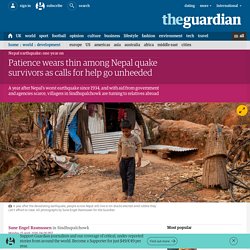
A year after the worst earthquake in 80 years hit Nepal, their patience with the government and international agencies has all but vanished. Clutching a pink smartphone with a patchy internet connection, connected to a loudspeaker so everyone can listen in, Ram Krishna calls the people they know they can count on: relatives and friends overseas, who will send home remittances. He places a Viber call to Saudi Arabia. At the other end of the line, migrant workers have convened to discuss how to help. But they have barely begun the meeting before the connection cuts. “I hope it helps but migrant workers earn so little they can’t send much,” says Govindra Buri, 74, as a younger man carries the loudspeaker away. The earthquake lasted approximately 50 seconds but it will upend people’s lives for years. Acts of kindness that helped the people of Nepal survive the earthquake – in pictures.
Earthquake survivors left stranded in Nepal as red tape stops aid flowing. Donors drummed up billions of dollars for Nepal after the devastating earthquake on 25 April 2015, but the trickle of money to the affected population has been excruciatingly slow.
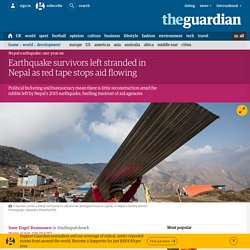
Despite pledges of $3bn, few of the 3.5 million Nepalese needing assistance have received more than initial handouts that are not even enough to clear the rubble. Across the Himalayan country, where the quake destroyed about 600,000 houses, 34,000 classrooms and killed close to 9,000 people, many Nepalese still live in shacks of corrugated iron next to mounds of mud and stone, formerly their homes.
To get here, aid money has to move through a thicket of political bickering and bureaucratic hitches. A controversial constitution triggered protests in the south, a four-month blockade of the border with India – Nepal’s main trading partner, and led to a new government in October. However, Teerink admitted that international donors could have prepared better for a disaster that was widely expected.